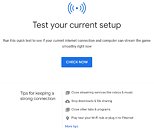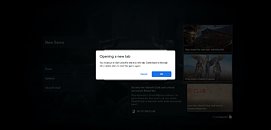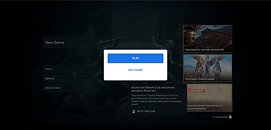Thursday, January 17th 2019

Impressions of Google's Project Stream: Game Streaming in 2019 Actually Seems Feasible
What happens when Google, AMD, and Ubisoft get together? Aside from pleasantries, it leads to Project Stream- a surprise announcement in late 2018 from the online giant, which clearly was part of their getting into the gaming space. Google had teased entries into more dedicated gaming hardware and software alike, with those presumably on the way, and Project Stream is going to be a big part of that equation in 2019, if not the gaming market in general.
Picture being able to play AAA games at 1080p and 60 FPS on an internet browser, with the only requirements being a decent enough internet connection (the test called for 25 Mbps down, and no mention on minimum upload speeds) and a controller or keyboard/mouse combo. This would have been a pipe dream even with NVIDIA's own take on this, GeForce Now, having been announced significantly earlier. However, that has yet to come out of a private beta test, and even so shows no sign of leaving a limited test region centered around the USA and EU. Perhaps it was fitting then that AMD, with their RadeonPro GPUs providing the horsepower, helped lay the ground for the most convincing public test of game streaming to date.
Okay, so I was not convinced when I first read about it in October last year. After all, why would I want a potentially sub-par gaming experience that can change graphical quality at a whim, challenge my poor ISP-mandated data cap, and play more Assassin's Creed of all games? I had burned out on that series after trying out Unity, but gave Syndicate a chance and, while it was better, it was still more of the same. I skipped Origins (at least for now), and Odyssey seemed to be an entry back after not a whole lot of time for Ubisoft into that series. TechPowerUp's own testing of the PC port was encouraging, but what really got me to pull the trigger was (a) to see if I could perhaps do some form of performance analysis of Project Stream, especially given this was limited to the USA and there are not too many of us TechPowerUp editors over here, and (b) news coming out that testers who had a minimum of an hour of gameplay would get a copy of the game for free on Uplay for PC, and have their save files transferred too.
Indeed, it appeared that I was either not the only one skeptical or Google simply wanted a lot more people involved. They had even offered $10 worth of in-game currency for the usual microtransactions Ubisoft sees fit to add to their $60 games, an offer which no doubt was from Ubisoft more so than Google themselves. So here I was in December, with not a whole lot planned over the holidays, and decided I might as well give this a shot. Boy, was I glad I did..Before I could actually go about playing, Google had to make sure I met all requirements (which included using Google's Chrome browser) and a quick, ~20 second speed test confirmed all was good to go. Hitting the play option effectively then started the game stream immediately, with subsequent activity leading to the game starting with the usual Ubisoft game loading screens. Indeed, I could not have predicted that this would be such a smooth launch- with first impressions being so important for new technology, this definitely worked well in its favor. The game menu itself told me I was not playing a typical Uplay game, however, with tiles informing me I have 1000 Helix Credits (the aforementioned $10 for microtransactions), and that in turn leads to the in-game page where I could redeem it for whatever I wanted. The last tile at the bottom was telling me that I had to open Uplay on a new tab to access Ubisoft's Club, to check my social activity, game credits, and redeem them for more Club rewards. Indeed, it was confusing on how to actually exit the game and stream from the forced full screen mode- especially if you missed the short notice that plays upfront- and holding down Esc brings up a nifty play/exit option and minimized the window back to the browser tab at any time which is handy for when you want to take a break but not actually exit the game.Before I could do any gaming, I simply had to check the options menu and, well, it was basically the PC version port except without the graphics sub-menu. Ah, of course, this was more akin to a console game experience thus, with Google effectively telling me I could get up to 1080p/60 FPS gameplay but without any mention of the quality setting. There was no in-game benchmark either, because of course this would also depend a lot on my internet connection and what other network activity was ongoing, so all I can tell was Project Stream's beta test of Assassin's Creed Odyssey ran somewhere around the "High" setting on the PC when all worked well, but could dip into lower categories if needed. Such an adaptive gameplay experience can be jarring to PC gamers, but is absolutely critical for game streaming to work at this time.If the experience thus far was smooth, what happened next was rough- literally, with the starting cutscene alone displaying choppy framerates, quality dipping firmly into the low setting, and a "Spotty Connection" notification popped up at the bottom right corner which, when expanded for details, was not really any more useful than saying my internet connection could have been less-than-optimum. Well, of course, I was on Wi-Fi here and had many other tabs open but it was still surprising when the initial speed test was successful, and I typically exceeded 100 Mbps download speeds on Wi-Fi on this very PC. Perhaps this was a one-off, so I exited the game to switch over to Ethernet and also check what was going on with Wi-Fi, and was promptly greeted by a feedback survey. This does not come up each time you quit the game, and you can also pull it up at any time, so that was good user experience design already.
As it turns out, my NETGEAR XR500 router (review here, for those interested), was still set up for geo-filtering close to my location for when I was doing that review. I don't really play online, and clearly that was what was causing the issue here. There have also been some complaints about others, without this filter and the same router, having an adverse effect with Project Stream, so I am discussing more with NETGEAR about this. A quick switch of routers solved that issue, but I used Ethernet connectivity henceforth (until the very end for more testing).I tried a variety of factors to try and influence my gameplay experience outside of just controlling internet speed- be it a controller, a wireless keyboard and mouse, a wired peripheral set, and stream latency was generally not an issue when the internet connection was good. No complaints either as far as performance or graphical fidelity goes, with ~90-95% of my nearly 50 hours on this service being extremely satisfactory. I kept monitoring how much data this service took, and this is definitely one of the things to be aware of. The entire game by itself is about 46 GB to download off Uplay, but each time you exit the game and come back on Project Stream, the same environments are loaded over and over. I estimate approximately 70 GB to have been used up by this service in my 50 hours, which is not a lot for most, even in the USA where the test was localized to, but will definitely be a challenge when this service eventually goes global. There are some built-in measures, however, including a 20 min inactivity tracker that closes the game automatically in case something came up, so such small quality of life improvements will be handy.
[Update: January 19, 2019- With the test complete, I went back and did a more comprehensive calculation. The final numbers for data usage appear to be a lot more than 70 GB and closer to 300 GB instead, which does change things a lot. Indeed, others noticed 6-7 GB/hour on Project Stream and this can be a definitely deal breaker for those with a capped internet plan.]
Sure, the draw distance may not have been as high as it would have been on my PC, and very likely I could have upped graphics to 4K and Ultra giving better shadows and lighting. But the convenience of being able to play whenever, wherever without worrying about what PC you are on was something I could get used to. Not having to deal with Uplay much is always nice, but note that you still need to be connected to Uplay for saves to be retained given there is no local storage here. Google will also have to defend the use of Chrome as the exclusive browser in the EU or risk another lawsuit, when this eventually goes live and public around the world, and pricing as well as game title availability will make or break this service. With the more accurate data usage numbers in hand, that is another issue for Google to tackle as well. I suspect Project Stream will lead to a live service to tie into Google-branded hardware consoles that are not the strongest as far as processing capabilities go, but capable enough to stream games for more than just the casual gamer. There are many questions left to be answered, but I leave the test, which ended a little over a day ago as of the time of this article, mostly convinced and wanting more.
Picture being able to play AAA games at 1080p and 60 FPS on an internet browser, with the only requirements being a decent enough internet connection (the test called for 25 Mbps down, and no mention on minimum upload speeds) and a controller or keyboard/mouse combo. This would have been a pipe dream even with NVIDIA's own take on this, GeForce Now, having been announced significantly earlier. However, that has yet to come out of a private beta test, and even so shows no sign of leaving a limited test region centered around the USA and EU. Perhaps it was fitting then that AMD, with their RadeonPro GPUs providing the horsepower, helped lay the ground for the most convincing public test of game streaming to date.
Okay, so I was not convinced when I first read about it in October last year. After all, why would I want a potentially sub-par gaming experience that can change graphical quality at a whim, challenge my poor ISP-mandated data cap, and play more Assassin's Creed of all games? I had burned out on that series after trying out Unity, but gave Syndicate a chance and, while it was better, it was still more of the same. I skipped Origins (at least for now), and Odyssey seemed to be an entry back after not a whole lot of time for Ubisoft into that series. TechPowerUp's own testing of the PC port was encouraging, but what really got me to pull the trigger was (a) to see if I could perhaps do some form of performance analysis of Project Stream, especially given this was limited to the USA and there are not too many of us TechPowerUp editors over here, and (b) news coming out that testers who had a minimum of an hour of gameplay would get a copy of the game for free on Uplay for PC, and have their save files transferred too.
Indeed, it appeared that I was either not the only one skeptical or Google simply wanted a lot more people involved. They had even offered $10 worth of in-game currency for the usual microtransactions Ubisoft sees fit to add to their $60 games, an offer which no doubt was from Ubisoft more so than Google themselves. So here I was in December, with not a whole lot planned over the holidays, and decided I might as well give this a shot. Boy, was I glad I did..Before I could actually go about playing, Google had to make sure I met all requirements (which included using Google's Chrome browser) and a quick, ~20 second speed test confirmed all was good to go. Hitting the play option effectively then started the game stream immediately, with subsequent activity leading to the game starting with the usual Ubisoft game loading screens. Indeed, I could not have predicted that this would be such a smooth launch- with first impressions being so important for new technology, this definitely worked well in its favor. The game menu itself told me I was not playing a typical Uplay game, however, with tiles informing me I have 1000 Helix Credits (the aforementioned $10 for microtransactions), and that in turn leads to the in-game page where I could redeem it for whatever I wanted. The last tile at the bottom was telling me that I had to open Uplay on a new tab to access Ubisoft's Club, to check my social activity, game credits, and redeem them for more Club rewards. Indeed, it was confusing on how to actually exit the game and stream from the forced full screen mode- especially if you missed the short notice that plays upfront- and holding down Esc brings up a nifty play/exit option and minimized the window back to the browser tab at any time which is handy for when you want to take a break but not actually exit the game.Before I could do any gaming, I simply had to check the options menu and, well, it was basically the PC version port except without the graphics sub-menu. Ah, of course, this was more akin to a console game experience thus, with Google effectively telling me I could get up to 1080p/60 FPS gameplay but without any mention of the quality setting. There was no in-game benchmark either, because of course this would also depend a lot on my internet connection and what other network activity was ongoing, so all I can tell was Project Stream's beta test of Assassin's Creed Odyssey ran somewhere around the "High" setting on the PC when all worked well, but could dip into lower categories if needed. Such an adaptive gameplay experience can be jarring to PC gamers, but is absolutely critical for game streaming to work at this time.If the experience thus far was smooth, what happened next was rough- literally, with the starting cutscene alone displaying choppy framerates, quality dipping firmly into the low setting, and a "Spotty Connection" notification popped up at the bottom right corner which, when expanded for details, was not really any more useful than saying my internet connection could have been less-than-optimum. Well, of course, I was on Wi-Fi here and had many other tabs open but it was still surprising when the initial speed test was successful, and I typically exceeded 100 Mbps download speeds on Wi-Fi on this very PC. Perhaps this was a one-off, so I exited the game to switch over to Ethernet and also check what was going on with Wi-Fi, and was promptly greeted by a feedback survey. This does not come up each time you quit the game, and you can also pull it up at any time, so that was good user experience design already.
As it turns out, my NETGEAR XR500 router (review here, for those interested), was still set up for geo-filtering close to my location for when I was doing that review. I don't really play online, and clearly that was what was causing the issue here. There have also been some complaints about others, without this filter and the same router, having an adverse effect with Project Stream, so I am discussing more with NETGEAR about this. A quick switch of routers solved that issue, but I used Ethernet connectivity henceforth (until the very end for more testing).I tried a variety of factors to try and influence my gameplay experience outside of just controlling internet speed- be it a controller, a wireless keyboard and mouse, a wired peripheral set, and stream latency was generally not an issue when the internet connection was good. No complaints either as far as performance or graphical fidelity goes, with ~90-95% of my nearly 50 hours on this service being extremely satisfactory. I kept monitoring how much data this service took, and this is definitely one of the things to be aware of. The entire game by itself is about 46 GB to download off Uplay, but each time you exit the game and come back on Project Stream, the same environments are loaded over and over. I estimate approximately 70 GB to have been used up by this service in my 50 hours, which is not a lot for most, even in the USA where the test was localized to, but will definitely be a challenge when this service eventually goes global. There are some built-in measures, however, including a 20 min inactivity tracker that closes the game automatically in case something came up, so such small quality of life improvements will be handy.
[Update: January 19, 2019- With the test complete, I went back and did a more comprehensive calculation. The final numbers for data usage appear to be a lot more than 70 GB and closer to 300 GB instead, which does change things a lot. Indeed, others noticed 6-7 GB/hour on Project Stream and this can be a definitely deal breaker for those with a capped internet plan.]
The other ~5-10% of my time testing was not perfect, however, with two random crashes out of nowhere and occasional spotty connection-related issues. Above is a quick video on how it appears in-game, and note that the first few seconds show off what I presume is Ubisoft's game engine bugging out rather than Project Stream itself. I then throttled internet speed to 20 Mbps down for the PC to see what would happen, and it got bad. Graphics quality dipped down first, sacrificing visuals for performance, but then the framerate dropped as well and now input latency was a real issue. There was a noticeable lag, as much as 0.5-1 second at times, from when I hit a button to trigger an action to when said action occurred. Looking at the online Google community for Project Stream, which has since been taken down as well, it appears that the vast majority of users were more than happy with the gameplay experience.
Sure, the draw distance may not have been as high as it would have been on my PC, and very likely I could have upped graphics to 4K and Ultra giving better shadows and lighting. But the convenience of being able to play whenever, wherever without worrying about what PC you are on was something I could get used to. Not having to deal with Uplay much is always nice, but note that you still need to be connected to Uplay for saves to be retained given there is no local storage here. Google will also have to defend the use of Chrome as the exclusive browser in the EU or risk another lawsuit, when this eventually goes live and public around the world, and pricing as well as game title availability will make or break this service. With the more accurate data usage numbers in hand, that is another issue for Google to tackle as well. I suspect Project Stream will lead to a live service to tie into Google-branded hardware consoles that are not the strongest as far as processing capabilities go, but capable enough to stream games for more than just the casual gamer. There are many questions left to be answered, but I leave the test, which ended a little over a day ago as of the time of this article, mostly convinced and wanting more.
















58 Comments on Impressions of Google's Project Stream: Game Streaming in 2019 Actually Seems Feasible
The rest of the target audience is the console gamer... that already has access to cheap gaming hardware that surpasses a streamed experience..
So what is left? Some middle ground audience with no money that does want to game and hasnt fallen for smartphones. Yeah.. no. Not gonna fly
hell even emulating old 8 bit games poorly which results in small input lag is horrible, Input lag is a massive factor in gaming..
You could possibly get away with streaming games like tropico or the sims in single player where a few ms of input lag isnt going to ruin the game, but trying to play anything else?? I cannot think of a situation where it would be at all viable.
in this day and age input lag is not a viable trade off for any thing.
you would be better off with a low powered pc that can only run the game at low details 1080p and hit a constant 30fps than suffer with input lag which i cannot see being better than an average of 25-50ms on a good day.
and most probably will be pushing 200ms or at least spiking that high.
Can i rent a kidney while were at it too?, so when i havent paid for it at the exact moment i need to update my sub for it, my kidneys fail?, that would be nice, i guess.
they can do whatever they want ...
I've tried OnLive before it was bought by Sony, and even on my then shitty and unstable 25Mbit/s it was smooth and perfect, even though the nearest datacenter was somewhere in UK [!!!!] (routing from Ukraine is probably as bad as US or Australia). Played Witcher 2.
Amazon AWS has very little presence in eastern europe (hence Bethesda online services suck so much), and Microsoft is still doing baby steps in this direction. Playstation Now has no local coverage either, and Nvidia's Geforce Now is currently limited to Shield users (PC/MAC users are on a waitlist).
If anyone can do it properly and on a large scale - it's Google. Can't wait to test it on my 100Mbit/s connection.He's not talking in-house streaming. Shield TV was the first platform for GeForce Now streaming services (it's still in beta, but supposedly it will remain free with Shield TV).
How do you think it plays all of those AAA games, like RoTR or Prey, on a puny tablet hardware?That's an american problem, not a streaming problem. Write a petition to whoever is your next president gonna be, sue AT&T, Comcast and others. As soon as you break the monopoly on comms services and smaller companies get access to local exchange networks at liberal prices, it'll become as cheap and as fast as everywhere else in the world.
there are plenty of other reasons but, most of all its sad that single player gaming is relegated to back-foot.
can't wait for cyberpunk and metro soon enough.
Assuming they offer this at an affordable price, getting new releases for a monthly fee is going to be VERY attractive. If you can afford a high-end computer, maybe not, but to the vast majority of mainstream gamers, yes.
Not that long ago you may have bought a q6600 and a 8800 gt which for those 2 components new on release would have been about $1200 ..
a few years later you could buy a a8-8350 for $135 which was near identical performance..
hardware gets better and the low end stuff becomes as good as the old highest end stuff And as stated, you would be better off throwing together a pc that can run 1080p low settings constant 30fps than suffer with any sort of input lag. And a system like that really does not cost much in this day and age. You only really need to start throwing money at pc's when your trying to run higher refresh rates at higher resolutions.
I'm pretty happy gaming at 75hz 1920x1200 So my system does not need to be as powerful as many of the ones other forum members own.